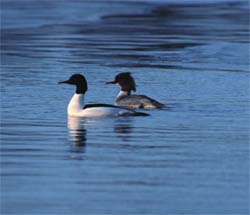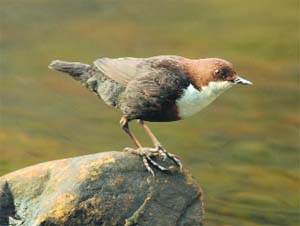|
MAKING YOUR VISITORS WELCOME
When we talk about wildlife habitats we usually think of bogs, heathland
or marshes but one of the most widespread and increasingly important habitats
is suburban gardens. If you’d like to try and make your garden more
attractive to birds and other wildlife there’s a illustrated free talk
on how to do that at the Kingston Hotel, Dun Laoghaire at 8.00pm Tuesday
8th September. In the first talk of the winter season the South Dublin Branch
of Birdwatch Ireland will be showing how you can help wildlife and especially
birds through planting, feeding and providing nesting and roosting sites.
We’ll also be showing what birds you are likely to get visiting the
garden. Many birds survive the winter, and some of our colder summers, purely
by the food that is provided to them in gardens through feeders and food
plants and it’s good to know you’re helping these birds survive
as well as the obvious pleasure you can get from watching them up close.
There will be a shop at the meeting selling bird food, feeders and books.
Everybody welcome and free entry.
TAKING TO THE WATER IN
WICKLOW
We’d
been for a drive over the Dublin Mountains and found ourselves in Laragh
so I thought if there’s room in the free car park we’ll try
Glendalough. Although Glendalough seems to have a mini climate of its own,
a very humid and usually very wet one, we’d already driven through
a torrential shower and reckoned we’d had our quota of rain for a
while. Even with all the sightseers and coachloads of tourists that visit
Glendalough it’s still a very peaceful serene place and it doesn’t
take much effort to get off the busier paths and find yourself alone among
the trees with only a few thousand midges for company. Anyhow we had no
problem getting parking and we set off wandering around the lakes. Glendalough
has some uncommon species of birds breeding there but late afternoon in
August wasn’t a good time to see them and we’d be happy to
have a nice walk without getting drenched. Some birds that are relatively
common in the oak woods of Wales just a few miles across the Irish Sea
are almost exclusively only found in Ireland around Glendalough including
Redstarts and Wood Warblers which arrive in spring to breed among the oaks,
the damp warm woodlands providing lots of insect food. It’s also
one of the best places in Wicklow to see Jays, another oak wood specialist.
|
| A
relatively recent addition to Glendalough are Goosanders, a saw billed
fish eating duck, similar to, but much rarer than the Merganser which
are regularly seen off the coast. These birds are often seen on the lakes
in the early morning before it gets busy but as soon as the visitors arrive
they fly down to the Avonmore River. They were first seen on the river
in the 90’s and are now breeding successfully in Wicklow due to
the provision of nest boxes placed on tree trunks which replicate the
holes in trees they normally nest in. When the chicks are ready to leave
the nest they will jump out of these holes to the ground, a big jump for
a small bird, and then they’ll follow their mother to the water.
We visited the National Parks Interpretive Centre which has a great collection
of presumably very old) stuffed animals and interesting displays of creatures
and their nests that are common around the area. I was glad to hear that
very few
Grey Squirrels are found around Glendalough and the Reds are still very
prevalent.
|
 |
 |
Coincidentally
the person working in the interpretive centre was actually from Killiney
and she remembered when she was young having red squirrels in the garden
of her family home, sadly all gone, replaced by greys. We walked on towards
the larger lake. I’d been keeping an eye on the little streams but
of course it was my much sharper eyed companion who spotted what I’d
been looking for.
Perched on a stone in the little stream about 20 feet away was a Dipper.
These are lovely plump, almost round, little birds. Dark wings and back
while their chest and lower front is a lovely chocolate brown colour with
a contrasting snow white bib around their neck. They’re always found
in or beside fast flowing streams or rivers where they bob up and down
on rocks before plunging into the water. They feed by swimming or walking
along the stream bed picking up insects such as beetles, bugs, mayflies,
stoneflies and their larvae and even catching |
| little
shrimps. Apart from the white chest, the constant bobbing motion and frequently
flicking tail there’s something else very striking about the dipper.
When it blinks it’s like a little camera shutter opening, as a metallic
flash descends over it’s eyes. This is a thin film called a nictitating
membrane, which acts as a thin, transparent eyelid to protect the eye when
it’s underwater, enabling the bird to see its prey. I’d never
seen one so close and our presence didn’t seem to bother it at all,
presumably it was used to all the activity around the lakes and we watched
it stepping in and out of the water plucking out what looked like larval
cases. By the lakeside we saw Grey Wagtails and a couple of Ravens croaked
their way overhead. The many inaccessible cliffs around the lake make it
an ideal habitat for ravens and peregrines. Lots of Chaffinches, Chiffchaffs
and Treecreepers and a unexpected small flock of Crossbills enlivened our
return walk and it wasn’t even a good time of the year to see or
hear birds. And the rain kept off. Must go back in the Spring. |
|



